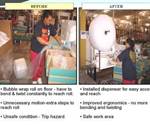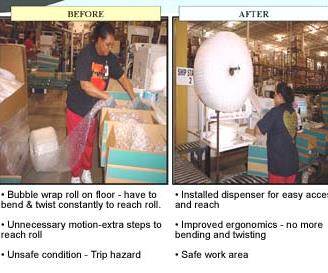Focus on Processes, Not Operations
You want both machines and people to work correctly, but with the wrong emphasis you put your energies in the wrong direction.
Dr. Shingo defines process as “a flow by which an object is transformed from raw material into finished product,” as opposed to operations, which is “the flow of tasks performed by human workers on products.” The focus needs to be on improving processes and not operations.
A subtle, but very powerful difference. In the past we focused on getting our equipment to run at maximum speeds to produce the highest volume of products—creating mountains of inventory without considering the exact needs of our customers.
You want both machines and people to work correctly, but with the wrong emphasis you put your energies in the wrong direction. For example, we in America were thoroughly convinced by our accounting systems that in order to maximize productivity from our machines, “Push the metal out the door,” was the right motto. Instead, Dr. Shingo believes you must ensure that you are using and maximizing the proper system—reducing costs and eliminating all defects—the heart of continuous improvement.
Identifying and Eliminating Waste
When buying an automobile you want to pay only for the value adding not for the manufacturing wastes. Value adding are the steps in manufacturing to convert raw material to finished goods—milling, grinding, stamping, attaching, etc. If defects are made while manufacturing, why should the customer have to pay for the cost to produce those defects—it is a waste and the customer should not have to pay for those wastes.
The concept of waste is at the heart of lean manufacturing. If you understand exactly what waste is, you can quickly move lean throughout your company. Companies spend years not knowing what waste is, so they are unable to find it and remove it. They spend the bulk of their time trying to speed up machines, bringing in new technology, trying to solve horrendous defect problems without really knowing the fundamental reasons why wastes are being created.
Getting to the root cause to eliminate problems and defects is close to the heart of lean manufacturing. Just solving a problem to allow it to occur again is such a waste of human ingenuity. Dr. Shingo teaches to spend a little more time up front investigating causes a little deeper to ensure that the same problem would never happen again.
The Toyota Production System, which visualizes the entire factory as a one-piece flow system, cannot work unless defects are eliminated. If one machine stops then the whole plant stops. Producing defects is one of the most significant wastes in the Toyota Production System. Most of us have the same problem. We are surrounded by waste, but without understanding what waste really is we can’t identify it or remove it.
For example, take the whole idea of supply chain management. We’ve always felt that it was necessary to have large amounts of inventory to supply products to our customers. We needed large warehouses to house the inventory; we needed to automate the warehouse to speed up the delivery process; we needed an elaborate accounting system to manage the inventory; we needed skids and forklifts to move the inventory around; we needed a vast array of shelving; we needed a large staff of people to do the moving, packing and shipping; we needed incoming and outgoing inspectors, etc., all adding to the cost of manufacturing—all is waste.
In all sports activities the score is always in sight. We might think that we are playing the game solely to win, but not really. We play for the exercise, we play to improve ourselves, we play for the companionship; we play for the excitement, the thrill. We feel good about the doing; we feel good about reaching for new heights, and, yes, if we lose our ego doesn’t like it, but the real benefits have been achieved just from the process. Winning is important, but often it clouds the real issue. You can win next time; it comes as you improve. It is only a matter of time.
Dr. Shingo teaches that the target is the complete elimination of all non-value adding wastes, and since in some sense there always is waste, we never stop improving. The meaning of the word subtly changes as we improve. We start at the obvious, the gross and then we refine it.
(The aforementioned is based on topics from from "Kaikaku The Power and Magic of Lean". Dr. Shigeo Shingo was the co-creator with Taiichi Ohno of the Toyota Production System more commonly known as lean manufacturing.)
Related Content
The Role of Social Media in Manufacturing
Charles Daniels CFO of Wepco Plastics shares insights on the role of social media in manufacturing, how to improve the “business” side of a small mold shop and continually developing culture.
Read MoreHands-on Workshop Teaches Mold Maintenance Process
Intensive workshop teaches the process of mold maintenance to help put an end to the firefighting culture of many toolrooms.
Read MoreMaking Quick and Easy Kaizen Work for Your Shop
Within each person is unlimited creative potential to improve shop operations.
Read MoreDynamic Tool Corporation – Creating the Team to Move Moldmaking Into the Future
For 40+ years, Dynamic Tool Corp. has offered precision tooling, emphasizing education, mentoring and innovation. The company is committed to excellence, integrity, safety and customer service, as well as inspiring growth and quality in manufacturing.
Read MoreRead Next
Making Quick and Easy Kaizen Work for Your Shop
Within each person is unlimited creative potential to improve shop operations.
Read MoreAre You a Moldmaker Considering 3D Printing? Consider the 3D Printing Workshop at NPE2024
Presentations will cover 3D printing for mold tooling, material innovation, product development, bridge production and full-scale, high-volume additive manufacturing.
Read MoreHow to Use Continuing Education to Remain Competitive in Moldmaking
Continued training helps moldmakers make tooling decisions and properly use the latest cutting tool to efficiently machine high-quality molds.
Read More
















